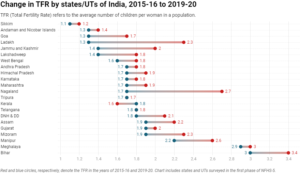In news
According to NFHS-5, India reports a remarkable decline in total fertility rate
What is the total fertility rate?
- Total period fertility measures the number of children a woman would have in the course of her life if the fertility rates observed at each age in the year.
- Total fertility is expressed as the number of children per woman. Total fertility (TF) is computed as the sum of age-specific fertility rates weighted by the number of years in each age group, divided by 1,000.
Key findings
- National Family Health Survey(NFHS)-5 finds that all states except Bihar, Manipur and Meghalaya have a TFR of 2.1 or less, which implies that most states have attained replacement level fertility.
- As per the survey, India’s population is said to be stabilising as the Total Fertility Rate (TFR) has decreased across the majority of the country’s states.

- Increase in modern contraceptives: All 17 states have witnessed an increase in the use of modern contraceptives of family planning.
- The proportion of women with an unmet need for family planning, who want to stop or delay childbearing but are not using any method of contraception, has declined in all states except Meghalaya and Andhra Pradesh.
- Contraceptive methods: Except for Manipur, all states have reported an increase in users getting information on side effects of current contraceptive methods.
- Sikkim recorded the lowest TFR, with one woman bearing 1.1 children on average; Bihar recorded the highest TFR of three children per woman.
- In 19 of the 22 surveyed states, TFRs were found to be ‘below-replacement’ — a woman bore less than two children on average through her reproductive life.
- Greater use of hygienic methods of protection by women during their menstrual periods in a number of states is among the key findings of the survey.
- Four years after the last survey (NFHS-4, 2015-16), the new findings merit urgent attention as they are considered the most comprehensive and robust data at scale on health and family welfare and emerging issues in the area
- Female sterilisation: As per the survey, Female sterilisation continues to dominate as the modern method of contraceptives in states such as Andhra Pradesh (98%), Telangana (93%), Kerala (88%), Karnataka (84%), Bihar (78%) and Maharashtra (77%)
- Teenage pregnancies: States like Manipur, Andhra Pradesh, Himachal Pradesh and Nagaland having shown an increase in the Teenage pregnancies.
- Along with an increase in child marriage, Tripura has also shown an increase in teenage pregnancies from 18.8% in 2015-16 to 21.9%.
















